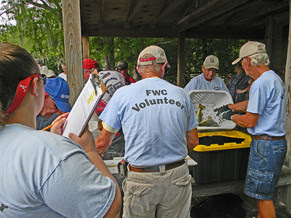In this edition, we explore the complexities of oyster restoration, contributions from the FWC's Highlands Lakes Volunteers towards a long-term fish monitoring program, as well as wiregrass planting along the Lake Wales Ridge by the Ridge Rangers. As we mentioned in our Spring-Summer edition, you, our dedicated volunteers are very much an integral part of our daily operations. We continue to appreciate your flexibility and understanding as we navigate best practices to ensure your safety.
— the FWC's Volunteer Program Team FWC's Highlands Lakes VolunteersBy Jim Reed  Bass tournament teams from FWC’s Highlands Lakes Volunteers collecting data for long-term monitoring of fish populations at Lake Istokpoga in Highlands County. Photo by FWC staff. Every year, FWC does long-term monitoring of fish populations on many of Florida’s most popular lakes, including Lake Istokpoga in Highlands County. Sampling and electroshocking to measure productivity and fish health are part of this long-term monitoring effort. For many years, some bass tournaments on Lake Istokpoga have been monitored, with a biologist collecting data on the fish brought to the weigh-in. More recently, this work has been conducted by bass tournament teams from FWC’s Highlands Lakes Volunteers. For the 2019-2020 season the team added a new set of data by examining each fish that came to the weigh-in for any signs of disease or physical problems. Each fish was evaluated and photographed if it displayed problems such as a visible tumor, a sore or fin loss. All this data, including length, weight (if possible) and fish condition, was collected while simultaneously ensuring the FWC work did not interfere with the flow of the weigh-in activities. In addition, team members helped provide authentication for TrophyCatch-eligible fish and helped the anglers get that credit. Between January and April, the tournament team usually visits one tournament weigh-in each weekend. However, this year’s activities were curtailed due to public health concerns. In the five tournaments visited in January and February this year, the team recorded data from 207 tournament bass. The data is utilized by the Fish and Wildlife Research Institute as part of a long-term monitoring program. John D. MacArthur Beach State Park Oyster Restoration Contractors use a crane to lift the limestone rock over the mangroves and place it along the shoreline. Photo by FWC staff. A collaborative effort to strengthen native oyster populations within the shallow 100-acre Lake Worth Cove estuary at John D. MacArthur Beach State Park has recently been completed. The Florida Fish and Wildlife Conservation Commission, in partnership with the Florida Department of Environmental Protection and volunteers from the West Palm Beach Fishing Club and John D. MacArthur Beach State Park, placed 120 tons of native limestone to restore oyster habitat. Oysters provide numerous ecological benefits, including improvement of water quality, habitat and food for wildlife, and erosion control. Surveys in the cove have found that hard surfaces, such as pilings and mangrove roots, support much greater densities of oysters than the estuary bottom. This led park managers to believe that the low densities of oysters may be due, in part, to limited hard substrate. A plan was developed to add hard substrate (limestone) to the shoreline at appropriate depths for oysters to colonize. However, the project faced a major challenge because the cove is surrounded by a mangrove fringe with no boat access. The only way to place the rock on the shoreline without causing damage to the mangrove shoreline was by airlifting it over the mangroves by crane. The next challenge was to move the rock to the planned locations and to stack it at the appropriate depths to maximize oyster recruitment. Volunteers to the rescue! Thanks to everyone’s hard work the limestone rock is now resting in its final destination and has already recruited a significant number of oysters that will serve to benefit water quality and wildlife usage within John D. MacArthur State Park and the greater Lake Worth Lagoon.  Volunteers spread limestone to create suitable substrate for oysters to inhabit. Photo by FWC staff. | 

No comments:
Post a Comment